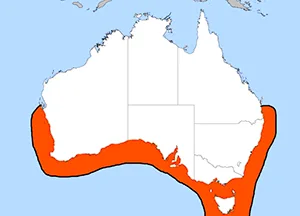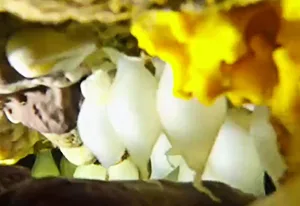Giant Cuttlefish - A Master of Camouflage

Contents
What Is a Cuttlefish?
Despite the name, the giant cuttlefish (Sepia apama), is not a fish. It is a cephalopod, closely related to octopuses and squids. The giant cuttlefish is a master of disguise. It can instantly change colours, patterns, and even skin texture to blend into its surroundings or mesmerise its prey. These remarkable adaptations are controlled by specialized skin cells called chromatophores, iridophores, and leucophores. Native to the southern coast of Australia, the giant cuttlefish is also known for its complex mating displays and seasonal aggregations in shallow waters.
Cuttlefish Description What Does a Giant Cuttlefish Look Like?
• Size: The giant cuttlefish can grow to 1 metre long (including tentacles) and weigh up to 10 kilos.
• Tentacles: The cuttlefish's two tentacles are built from coiled muscle fibres and are specially adapted to extend at lightning speed to snatch prey.
• Arms: The giant cuttlefish has eight specialised arms for grasping the prey snatched by its tentacles. These arms too do not have bones and are made of coiled muscle fibres. The cuttlefish also uses its arms for defensive display.
• Intelligence: Cuttlefish is very intelligent and has one of the largest brain-to-body mass ratios of any invertebrate.
• Masters of disguise: The Cuttlefish is an expert at camouflage and can quickly change its body colour, pattern, and texture using millions of tiny skin cells known as chromatophores. Sometimes, the cuttlefish can even make shapes with its tentacles to mesmerise its prey or to better blend into the background.
• Large outward-facing eyes: The cuttlefish has "W" shaped pupils that give it 360° vision. While colour-blind, it has excellent low-light visibility and can perceive contrast and polarization well.
• The cuttlefish has a pair of skirt-like fins: These span the length of its mantel and help it swim and manoeuvre. If rapid movement is required, it propels itself backwards by shooting a jet of water from its gut.
• The cuttlefish has a single internal bone-like structure called a cuttlebone, hence its name—cuttle-fish. This hollow and porous inner shell supports the fleshy parts of its body and gives it buoyancy. This cuttlebone acts like a swim bladder in fish and allows the animal to control the depth at which it lives.
• The giant cuttlefish has three hearts: Two pump blood to its large gills and one circulating oxygenated blood to the rest of its body.
• Blue-green blood: The giant cuttlefish's blood is blue-green because it contains a copper-containing protein called haemocyanin to transport oxygen through its body. (Mammals use the iron-rich protein haemoglobin for the same purpose).
• The giant cuttlefish has a parrot-like beak at the base of its arms to bite and subdue its prey. It also uses this sharp beak to defend itself from predators and other cuttlefish.
• The giant cuttlefish has a lifespan of two to four years and is mainly active during the day.
Cuttlefish Habitat

The giant cuttlefish live in rocky reefs, seagrass beds, and sandy or muddy seafloors at depths of up to 100 meters. They are found along Australia’s southern coastline, from Moreton Bay (Queensland) to Ningaloo Reef (Western Australia).
They avoid deeper waters because the water pressure would crush their delicate cuttlebone, causing death.
Cuttlefish Diet
The giant cuttlefish are carnivorous hunters feeding on
- Fish,
- Crabs,
- Molluscs,
- Shellfish,
- Even other cuttlefish.
The giant cuttlefish is an active and aggressive hunter that uses its colour-changing skills and tentacles to mesmerise its prey before pouncing on it. It may also camouflage itself and wait until an unsuspecting prey swims by to quickly grab it.
Cuttlefish Reproduction

The breeding season runs from April to September. During this time, thousands of giant cuttlefish gather for a spectacular mating display.
During this time, male cuttlefish put on extravagant mating displays. They alter the colour and texture of their skin, flare their arms and produce pulsating zebra stripes along the sides of the body to attract females and intimidate potential rivals.
Mating takes place head-to-head. The male transfers spermatophores, or small packages of sperm, to a particular area of the female where fertilisation takes place.
Females lay 100–300 leathery, white eggs in underwater crevices, then leave them to hatch on their own. The young emerge in 3–5 months. The giant cuttlefish has a lifespan of two to four years and is mainly active during the day.
Cuttlefish Predators and Threats
Natural predators of the giant cuttlefish include:
- Dolphins,
- Sharks,
- Large fish,
- Seals,
- Sea birds,
- Other cuttlefish.
Is the Cuttlefish Endangered?
The number of giant cuttlefish has declined drastically over recent years. They are impacted by overfishing and habitat degradation. The Giant Cuttlefish is also threatened by increased salinity levels which reduce the success of eggs hatching.